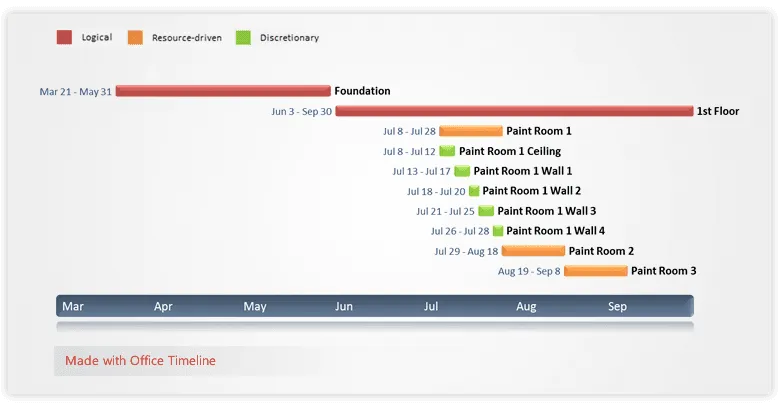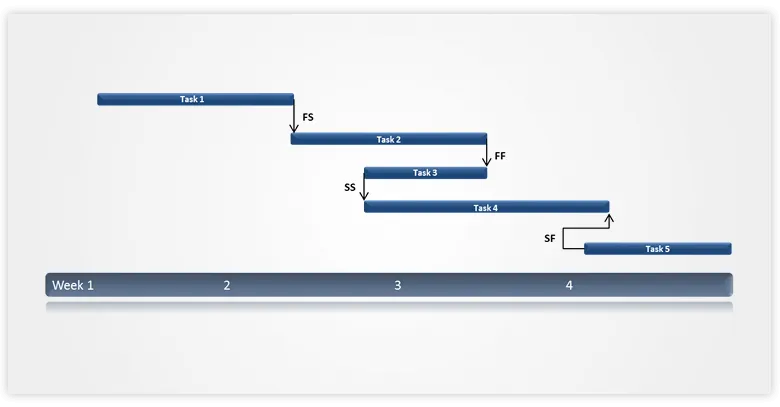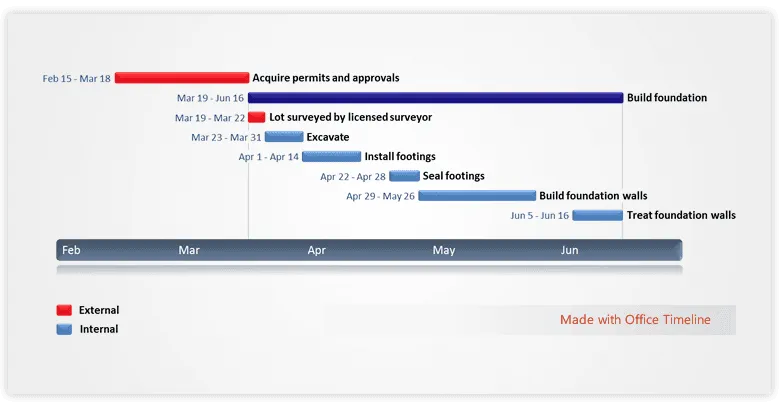How to identify and manage project dependencies
Learn practical tips on complex projects, find out how to identify and manage dependencies efficiently.
English poet John Donne said “no man is an island entire of itself; every man is a piece of the continent, a part of the main” – these words capture the realities of project management. No project, task or activity exists in isolation. One way or another, every activity relies on the output of others and contributes to the outcome of a project. The relationships between individual tasks or processes are called “dependencies”.
Keeping a record of all these linked activities and managing them effectively is essential for project planning, scheduling, tracking and execution. In the following article, we will take a brief look at project dependencies to help new PMs identify and tackle them more easily.
The main types of project dependencies
Dependencies can be classified in a number of ways based on criteria such as the causes behind them, predecessor-successor relationships, and whether the dependency exists between activities within the project or outside of it.
1. Logical, resource-driven and preferential dependencies
Based on what is causing them, dependencies can fall in one of the following three groups:
- Logical or causal dependencies are those driven by the nature of the project or of the tasks themselves. For instance, a construction team cannot possibly build the first floor of a building without finishing the foundation first. Identifying these dependencies is essential for creating accurate project plans and schedules.
- Resource-based dependencies occur between tasks that would be accomplished faster or simultaneously if there were more resources available. Where resource constraints are present, there usually are no logical dependencies to dictate the order of activities within a project. As an example, with enough manpower, it is logically possible to paint multiple rooms in a building simultaneously. If there’s only one painter available, however, the rooms will need to be completed one at a time.
- Preferential or discretionary dependencies refer to tasks that could be completed differently, but their implementation is decided by the team or PM based on convenience or guided by best practices. In our construction example, a room’s ceiling and walls can be painted in any order, but the painter prefers to finish the ceiling first because it”s more difficult to work on and he wants to get it out of the way.
While discretionary decisions may not seem that significant, it will make sense to document them, so that the logic behind them is known in future reports and reviews. Otherwise, this logic might be forgotten over time or questioned by clients, executives or any other stakeholders who weren’t initially involved in the task-scheduling process.
2. Predecessor-successor dependencies
Based on the relationship between the initiation and completion of individual tasks, dependencies can be classified into four major types:
- FS (Finish to Start) – The predecessor task must be completed before the successor can start.
- FF (Finish to Finish) – The successor cannot finish before the predecessor task is completed.
- SS (Start to Start) – The first task must start before the second task can be initiated.
- SF (Start to Finish) – One task cannot be completed before another one has started.
The most common and logical predecessor-successor relationship is the Finish-to-Start dependency, while Start-to-Finish is the most rarely encountered and may be puzzling to envision. To get a better grasp of SF relationships, it may be useful to think of how shift work is sequenced. If, for instance, a construction site requires 24/7 security services and there are a few guards working in shifts, the current shift cannot end before the relief security officers arrive, as the site would be left unattended.
3. Internal vs. external dependencies
Dependencies can also be classified based on the tasks’ relationship to the project, as follows:
Internal dependencies describe the relationship between two tasks or activities within the same project. The PM and the project team usually have complete control over these activities, and there is no involvement of any external parties. To manage these tasks effectively, discussing them with the project team is essential in order for each member to know exactly how their activities may impact other people’s work. This way, they will be more likely to notify the PM about potential problems, so that the necessary measures can be taken to manage the consequences.
External dependencies define those tasks that are dependent on outside influences, such as vendors, regulatory agencies, or even other projects. PMs and project teams don’t usually have much control (if any) over these dependencies. For instance, before construction workers can start building, renovating or demolishing, it is first necessary to obtain approvals from local authorities. The construction company cannot influence how long it will take the authorities to grant said approvals.
Although external dependencies are outside of a PM’s control, it is important to keep a thorough record of them, as they present risk to the project schedule. Also, it would be a good idea to notify any relevant third parties that the project team depends on them to be able to complete their own work. Explaining to non-project people how any late deliveries on their end can impact the project and encouraging them to provide timely progress updates can help PMs prevent possible issues and make any necessary schedule adjustments.
Tips for more effective dependency management
Managing task dependencies can seem overwhelming for a novice PM, especially considering that any slip may endanger the project. While it is impossible to prevent all potential issues, with good organization, planning and communication, even the most complex projects can be kept under control. Here are a few tips to help beginning project managers handle task dependencies more effectively:
1. Proper identification
The first step for effective dependency management is brainstorming all possible project dependencies and classifying them accordingly based on the criteria presented earlier. This can be done through a workshop or scheduled team meeting, where all team members – and, if possible, any other relevant parties involved – are brought together to discuss how their activities relate to one another, as well as how they may be affected by outside influences.
A common mistake that should be avoided at this stage is creating dependencies even when there aren’t any. Questioning and challenging the sequence of every step can produce forced or artificial dependencies, which may lead to unnecessary complications and delays.
2. Recording dependencies
Once all dependent tasks are identified, experienced project managers usually create a comprehensive dependency log for the project, which should include:
- an ID for each dependency
- description
- date
- the activities or people impacted by the dependency.
Also, it may be a good idea to calculate the probability of something going wrong with the linked tasks and to include an assessment of what would happen if the dependency is not delivered as planned. Alternatively, this data can be added to the risk log.
In addition, it is also worth nominating “owners” for each dependency by naming the person or people who will be responsible for how the linked tasks progress. When it comes to internal project activities, the task owner will usually be the natural dependency owner as well. In the case of external dependencies, such as a reliance on suppliers, someone within the project should be assigned to monitor the relationship with the supplier and ensure everything is on track.
Having a log of all the details mentioned above will prove to be helpful during the project planning and scheduling process, allowing PMs to effectively sequence tasks and develop strategies to minimize and mitigate risks.
3. Continuous monitoring and control
While identifying and documenting dependencies is important, it is their constant monitoring and control that will ensure the successful delivery of a project. Having a single session at the start of the project to examine dependencies is usually not enough. Therefore, experienced PMs schedule regular meetings to discuss how the linked tasks are progressing, if there are any changes in schedules or requirements, and whether those changes impact the connection between project tasks.
4. Efficient communication
There is no substitute for good communication when it comes to effective dependency management, and there are two key elements experienced PMs pay attention to:
- The project team. Ensuring all team members understand their responsibilities and are aligned when it comes to dependencies will help prevent many issues throughout the course of the project. In addition, day-to-day interactions and unity between team members can help resolve dependencies more easily and enable the project to move forward without constant manager intervention.
- Stakeholders. Engaging with clients and executives regularly and ensuring they understand how all dependencies can influence the project’s progress is important in order to set realistic expectations and avoid unfeasible requests. However, such stakeholders may not be familiar with PM jargon and may feel intimidated by complex Gantt charts or other intricate project management tools. This is why communicating the data using simple, familiar visuals such as PowerPoint slides and color-coding the related tasks can be a more effective way to present project dependencies to non-project audiences.
Project dependencies are inevitable, but managers shouldn’t feel threatened by them. With good communication and organizational skills, PMs can leverage them to their advantage and find effective ways to keep the project on track or even accelerate its execution.
Tim is Co-Founder & CEO of Office Timeline, a Seattle-based start-up that aims to rid the world of boring, uninspiring meetings.
Turn project data into professional timelines
Get the advanced features of Office Timeline free for 14 days.





